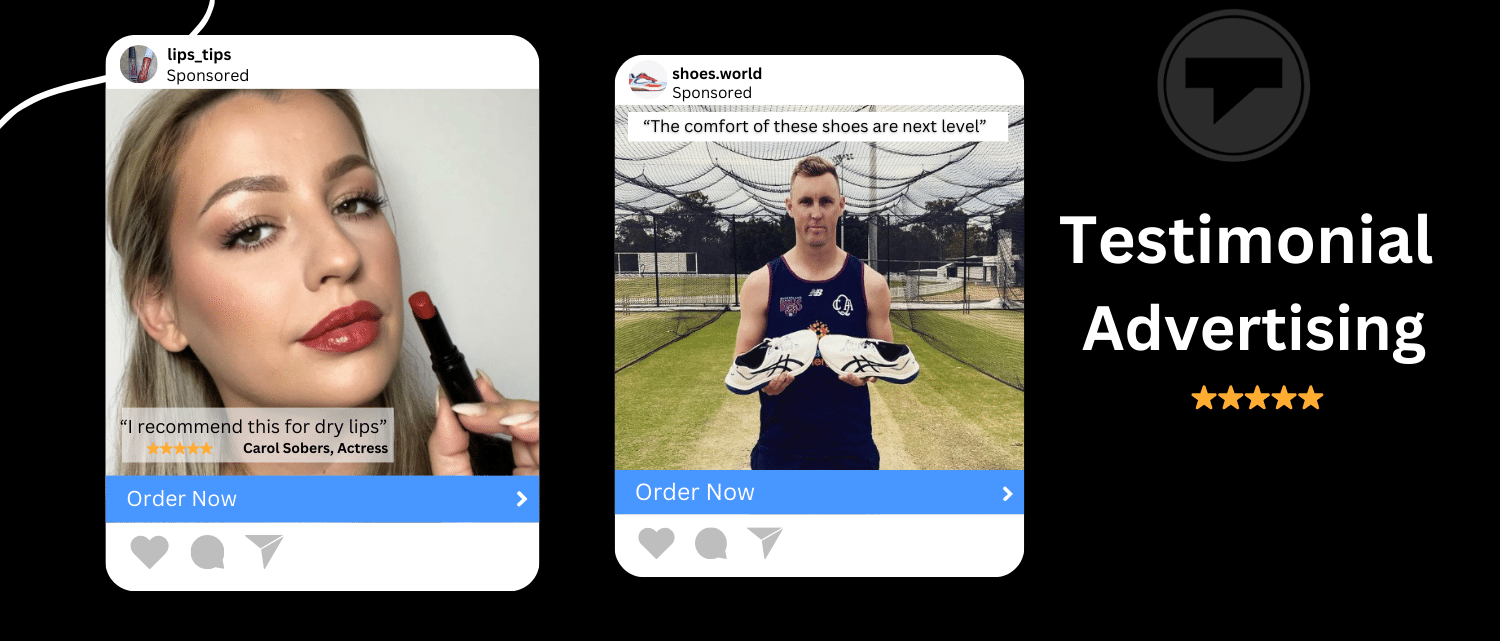Testimonial Advertising: Definition, Examples and Benefits
In the past, testimonials were often limited to written endorsements in print media or verbal endorsements in radio advertisements. Today, they encompass various formats, including video testimonials, social media reviews, influencer collaborations, and user-generated content (UGC).
This digital era has amplified the impact of testimonial advertising, enabling brands to reach wider audiences through various online platforms.
Moreover, the rise of transparency and authenticity in marketing has given rise to a new term,” Testimonial Advertising,” which is very popular among brands today.
Consumers now seek real experiences and opinions from their peers or credible sources before making purchasing decisions, emphasizing the importance of testimonial advertising in modern marketing strategies.
What is Testimonial Advertising?
Testimonial advertising involves leverage/ing endorsements, reviews, or recommendations from satisfied customers, influencers, or experts to promote a product, service, or brand. These testimonials aim to build credibility, trust, and social proof by showcasing positive reviews and opinions.
Historically, testimonial advertising dates back to early advertising practices, where word-of-mouth recommendations were key in influencing consumer behavior. However, with the evolution of media and technology, testimonial advertising has transformed significantly.
Why are Testimonials Important?
Testimonials hold significant importance due to their ability to tap into several psychological factors influencing consumer behavior.
Social Proof:
Humans are inclined to follow the actions of others, especially when uncertain. Testimonials serve as social proof, demonstrating that others have had positive experiences with a product or service. This phenomenon is powerful in influencing decisions, as individuals often look to peers for guidance in making choices.
Credibility:
Testimonials from real customers or recognized figures establish credibility. When a satisfied customer or an influencer endorses a product or service, it lends authenticity and reliability to the brand’s claims. This credibility helps mitigate skepticism and reinforces the value proposition presented by the brand.
Trust-Building:
Trust is fundamental in consumer relationships. Testimonials contribute significantly to building trust by providing third-party validation of a brand’s promises. They bridge the gap between a brand’s messaging and a potential customer’s skepticism, fostering a sense of trustworthiness that encourages purchase decisions.
Emotional Connection:
Testimonials often evoke emotional responses. When customers share personal stories or experiences, it creates a connection that goes beyond the features or benefits of a product. Emotional resonance can significantly impact consumers’ perception and inclination to engage with a brand.
Reducing Decision-Making Anxiety:
In a marketplace flooded with choices, testimonials serve as decision-making aids. They help alleviate the anxiety associated with making the wrong decision by offering insights and reassurance derived from others’ experiences.
By leveraging these psychological principles, testimonials become potent tools in marketing strategies. They not only persuade potential customers but also nurture long-term relationships by fostering a sense of reliability and empathy.
The ability of testimonials to resonate emotionally and psychologically with consumers contributes significantly to their effectiveness in influencing purchasing decisions.

Tips for Creating Effective Testimonial Ad Campaigns
After a few good conversations over coffee with some of the great marketers, I got a few tips they follow while running a testimonial ad campaign, so here are a few of them that I loved and want to share with you.
1. Identify and Understand Your Target Audience:
- Strategy: Conduct thorough audience research to understand demographics, preferences, pain points, and aspirations. Tailor testimonials to resonate with specific segments.
- Case Study: Airbnb’s “Host Stories” campaign featured diverse hosts sharing their experiences. By highlighting relatable stories, they effectively targeted both hosts and travelers, resonating with their respective needs.
2. Highlight Key Advantages with Specificity:
- Strategy: Encourage testimonials that specifically address unique selling points or benefits of the product/service. Specificity adds credibility and helps potential customers visualize the benefits.
- Case Study: Slack’s testimonials highlighted how their platform reduced internal email clutter, increased team productivity, and facilitated seamless communication. These specifics made their solution more tangible and appealing.
3. Experiment with Different Marketing Opportunities:
- Strategy: Utilize various formats and channels for testimonials—videos, written reviews, social media, and influencer collaborations—to reach diverse audiences and maximize impact.
- Case Study: GoPro’s user-generated content on social media served as powerful testimonials. Their customers shared thrilling action shots and experiences, showcasing the product’s capabilities across different user segments.
4. Craft Compelling Stories:
- Strategy: Encourage storytellers to share narratives that evoke emotions and resonate with your audience. Focus on authenticity and relatability to create memorable impressions.
- Case Study: Nike’s “Dream Crazy” campaign featuring Colin Kaepernick showcased powerful stories of athletes overcoming adversity, resonating with consumers and creating a strong emotional connection.
5. Incorporate Visual Testimonials:
- Strategy: Leverage visual elements such as videos or images in testimonials. Visual content tends to be more engaging and memorable.
- Case Study: Apple’s “Shot on iPhone” campaign featured stunning user-generated photos taken with iPhones. These visuals acted as testimonials, showcasing the product’s camera quality and encouraging user participation.

6. Leverage Influencer Testimonials:
- Strategy: Collaborate with influencers or industry experts whose audience aligns with yours. Their endorsement can significantly impact your target market.
- Case Study: Fashion Nova collaborated with influencers like Cardi B, who showcased the brand’s clothing in their posts. This partnership drove massive engagement and sales within the influencer’s audience.
Implementing these strategies effectively can significantly enhance the impact of UGC ads, creating resonance, trust, and engagement among your target audience.
Types of Testimonial Ads
Here are the types of testimonial ads you can run for your brand. To know which would best suit your brand, I have also listed the applications of each type. This will help you connect with brands and get an idea as to which one to go for.
1. Testimonial Videos:
Video testimonials offer a dynamic way to convey emotions, sincerity, and credibility. They can capture the storyteller’s facial expressions, tone, and context, making them highly engaging and relatable.
Application: Ideal for platforms like YouTube, social media, websites, and email campaigns. They work well when showcasing experiences, product demonstrations, or customer stories.
2. Text Testimonials:
Written testimonials provide detailed accounts and can be easily shared across various platforms. They are often concise, making them suitable for quick consumption.
Application: Commonly used in website review sections, social media posts, email newsletters, and marketing materials like brochures or flyers that you can create using graphic design maker.
3. Influencer Testimonials:
Leveraging influencers with engaged audiences can amplify reach and credibility. Their endorsement carries weight with their followers due to trust and perceived expertise.
Application: Utilized social media platforms, influencer collaborations, sponsored content, and product launches to access the influencer’s audience.
4. Organic Influencer(UGC):
Content generated by satisfied customers adds authenticity and social proof. It’s often shared voluntarily on social media or review platforms, boosting credibility.
Application: Utilized by brands through campaigns encouraging users to share experiences, reviews and ratings on social media platforms using specific hashtags or tags.
5. Success Story Testimonials:
Stories of successful customer outcomes highlight tangible benefits and inspire potential customers.
Application: Effective in case studies, newsletters, blog posts, or dedicated sections on websites to showcase how the product or service has positively impacted users.
Each type of testimonial ad has its unique advantages and applications. Choosing the right type—or a combination of types—depends on the campaign’s objectives, target audience preferences, and the message the brand aims to convey.
Testimonial Advertising Examples
1. Alan David Custom—Facebook Testimonial Ad:

An ad by Alan David Custom on Facebook features satisfied customers sharing their experiences with the brand’s custom clothing services. It leverages Facebook’s platform to showcase customer satisfaction and product quality.
2. Glossier—Instagram testimonial ad:

Glossier’s Instagram testimonial ad harnesses user-generated content to exhibit real-life experiences with their skincare and beauty products. The ad capitalizes on Instagram’s visual appeal and community engagement.
Headspace—Display testimonial ad:

Headspace employs display ads through Google’s Display Network to highlight testimonials emphasizing the mental wellness benefits of their meditation and mindfulness app.
Each campaign adapts its strategy to leverage the unique features and strengths of the respective platforms, aiming to engage audiences effectively while leveraging the power of testimonials to build trust and credibility.
How to Collect More Testimonials with Trust?
Tagbox is the best UGC platform designed to streamline and enhance the process of collecting and managing customer testimonials. It facilitates the collection of authentic and trustworthy testimonials by providing a platform that encourages customers to share their experiences, reviews, and feedback in a structured and easily manageable manner.
Here’s how Tagbox aids in collecting trustworthy testimonials:
- Simplified Collection Process: Tagbox offers a user-friendly interface that simplifies the process of submitting testimonials. Customers can easily navigate the platform and submit their feedback or stories.
- Structured Submission: The tool allows for organized submission of testimonials, often through predefined forms or fields, ensuring that the information provided is relevant and consistent.
- Verification and Moderation: Tagbox often includes features for verifying and moderating testimonials before publication. This helps in ensuring that only genuine and credible testimonials are showcased.
- Integration and Display: It often integrates with websites or marketing platforms, allowing for seamless testimonial display in various formats, such as widgets, sliders, or dedicated testimonial pages.
Using Tagbox effectively involves several steps:
- Setup and Integration: Set up Tagbox on your website or preferred platform. This involves creating forms or widgets where customers can submit their testimonials.
- Customization: Tailor the submission forms or fields to gather specific information that showcases the most relevant aspects of customer experiences.
- Promotion and Encouragement: Actively encourage customers to share their feedback through Tagbox. Utilize email campaigns, social media, or incentives to motivate customers to submit testimonials.
- Moderation and Verification: Review and moderate the submitted testimonials to ensure authenticity and relevance. Tagbox often provides tools for this process, allowing you to approve or reject testimonials.
- Display and Utilization: Once verified, display the testimonials across your website or marketing channels using Tagbox’s integration features. Utilize different formats and placements to maximize visibility.
- Engagement and Appreciation: Engage with customers who submit testimonials, thank them for their feedback, and show appreciation for their contribution to building trust and credibility for your brand.
By utilizing Tagbox effectively, businesses can create a streamlined process for collecting, managing, and displaying authentic testimonials, thereby enhancing credibility and trust among potential customers.
Get To Work
Time’s ticking! From videos to influencer endorsements, testimonial advertising wields immense power in today’s market. Understanding your audience, highlighting advantages, and leveraging tools like Tagbox is crucial. Act fast! Craft compelling campaigns to build trust and connections. Don’t miss out—get to work before it’s too late! Tagbox is here to help!







